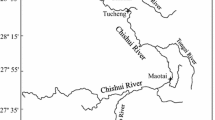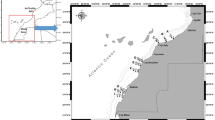Abstract
The concentration of heavy metals in fish is influenced by several factors, in particular, the biological differences (e.g. species, size, age, gender, sexual maturity, diet) and the environmental ones (e.g. water chemistry, salinity, temperature, and levels of contamination) (Carvalho et al. in Anal Bioanal Chem 382:426–432, 2005).
Access provided by CONRICYT-eBooks. Download conference paper PDF
Similar content being viewed by others
Keywords
1 Introduction
The concentration of heavy metals in fish is influenced by several factors, in particular, the biological differences (e.g. species, size, age, gender, sexual maturity, diet) and the environmental ones (e.g. water chemistry, salinity, temperature, and levels of contamination) (Carvalho et al. 2005). Numerous studies have shown that heavy metal accumulation in fish is strongly influenced by environmental concentrations, that is, their levels in the water and sediments. However, metal accumulation has been found to vary markedly between species in the same area, as a result of differences in feeding habits (Calta and Canpolat 2006). Heavy metals have a particular significance in ecotoxicology, since they are highly persistent and they all have the potential to be toxic to living organisms. Studies on heavy metals in rivers, fish and sediments (Ozturk et al. 2008), have been a major environmental focus especially during the last decade. Sediments are important sinks for various pollutants like pesticides and heavy metals and also play a significant role in the remobilization of contaminants in aquatic systems under favourable conditions and in interactions between water and sediment. As a consequence, fishes are often used as indicators of heavy metals contamination in the aquatic ecosystem because they occupy high trophic levels and are important food source (Agah et al. 2009).
This study was carried out to assess the levels of five heavy metals (zinc, lead, copper, iron and manganese) in the muscles of nine fin fish species and one shell fish, T. zilli, H. fiscalis, P. humile, C. hippo, C. acaudatus, Letjanus sp., C. nigrodigitatus, Sphyraena sp., S. maderensis and P. validus caught from Lagos Lagoon and landed at Makoko landing site, Lagos State, Nigeria. This study aimed at determining whether to the concentration of heavy metals in the tissues of the fish were within the permissible limits for human consumption.
2 Materials and Methods
The analysed fish muscles were collected in triplicates from different parts of the fish body. The fish samples were oven dried at 105 ℃ for about 12 h. The sediment samples were air dried. Dried fish samples were homogenized using a ceramic mortar and pestle. The fish and sediment samples were digested using the wet digestion procedure (Asegbeloyin et al. 2010). Muscle tissues were digested using the Kjeldahl digestion procedure (2003). The Atomic absorption spectrometer (AAS) (Analyst 200, Perkin Elmer) was then used to determine the concentrations of Lead, Manganese, Copper, Iron and Zinc in the fish samples. Laboratory blanks were prepared in order to ensure that the used samples and chemicals were not contaminated. They were analysed by atomic absorption spectrophotometry before sampling and their values were subtracted to ensure that the equipment read only the exact values of heavy metals. Each set of digestion has its own acid blank and was corrected by using its blank. The data were subjected to Analysis of Variance (ANOVA) using IBM SPSS version 20 after the logarithmic transformation was performed on the data to improve normality. The mean differences were separated at P < 0.05 levels of significance.
3 Results and Discussion
The Concentrations of Zn, Pb, Cu, Fe and Mn in the muscles of nine finfish species and one shellfish species analysed from Lagos Lagoon are shown in Table 1.
The concentration of zinc was the highest though it was within or less than the WHO acceptable limits for this metal in the muscles of fish. None of the sampled fish species had a consistently high or low level for all the five metals analysed. The overall average concentrations of Zn, Pb, Cu, Fe, and Mn in the muscles of the nine finfish species gave a ranking of: Zn > Fe > Pb > Cu > Mn. The metal levels in the muscles of each organism gave a similar ranking. Metal concentrations of lead, iron and manganese exceeded the maximum permissible levels for human consumption by (FAO/WHO 2017) .
P. validus had a significantly higher (P < 0.05) mean concentration of Zn (14.45 ± 0.08) than the other species. These levels of Zn concentration were much higher than the tolerable weekly intake (PTWI) of 7 mg/kg body weight equivalent to 490 mg/week for a 70 kg adult (FAO/WHO 2017). The concentrations of Pb were not significantly (P > 0.05) different from each other in five of the organisms as shown in Table 1. The mean concentration of Pb was in the following order Letjanus sp. > Sphyraena sp. > P. validus > S. maderensis > C. acaudatus > P. humile > T. zilli > C. hippo > C. nigrodigitatus > H. fiscalis. The provisional tolerable weekly intake (PTWI) for lead is 0.3 mg/kg body weight (FAO/WHO 2017). Lead has no biological role and is toxic to humans and other living organisms at very low concentrations. Other studies carried out on in Calabar River, Nigeria on Sphyraena sp. also revealed lead concentrations above acceptable limits.
Cu concentration was not significantly (P > 0.05) different among three of the organisms. The mean concentration of Fe was above the acceptable limit similar to Epe Lagoon (Taiwo et al. 2016). The maximum limit recommended by IAEA-407 (2003) is 146 mg/kg indicating that the concentrations of iron in the muscle of the fish species were far above the acceptable limits. The high level of Fe in the muscle of the fishes analysed are similar to the previous findings by Taiwo et al. (2016) who assessed heavy metals concentration in muscles and bones of organisms from Epe lagoon where the concentration of Fe was over the maximum recommended level by WHO.
Mean concentration of Mn was in the following order: Sphyraena sp. > Letjanus sp. > C. acaudatus > S. maderensis > C. nigrodigitatus > P. humile > P. validus = H. fiscalis > T. zilli > C. hippo. There were significant (P < 0.05) differences in manganese concentrations among fish species. The results of this study differ from those obtained by Taiwo et al. (2016) about the concentration of Mn from Epe Lagoon. Heavy metals in excess of the body needs of fish or human may constitute a major pollution source and pose serious health risks.
4 Conclusion
Heavy metals are toxic to both humans and fish, therefore, these compounds should be monitored regularly in the Lagoons. Zn, Fe, Cu, Pb and Mn are essential in human diet (Watts 1990), (National Research Council (US) 1993), their consumption should not exceed the limits set by FEPA, WHO and FAO. The high concentration of these metals in the fish species studied could render the fish dangerous for consumption. However, all the fishes had high lead content in excess of the provisional weekly table intake PWTI. Fish with high lead content should be avoided as much as possible. The level of pollution in Nigeria’s water bodies is quite high due to industrialisation and inadequate monitoring of dumping into the water bodies.
References
Agah H, Leermakers M, Elskens M, Fatemi SMR, Baeyens W. Accumulation of trace metals in the muscles and liver tissues of five fish species from the Persian Gulf. Environ Monit Assess. 2009;157:499–514.
Asegbeloyin IN, Onyimonyi AE, Ujam OT, Ukwueze NN, Ukoha PO. The presence of some heavy toxic trace metals in selected fish species and parts of domestic animals. Pak J Nutr. 2010;9(3):213–5.
Blamire J. Kjeldahl method. Science @ Direct. 2003 http://www.brooklyn.cuny.edu/bc/ahp/SDKC/Chem/SD_KjeldahlMethod.html.
Calta M, Canpolat O. The comparison of three cyprinid species in terms of heavy metals accumulation in some tissues. Water Environ Res. 2006;78:548–51.
Carvalho ML, Santiago S, Nunes ML. Assessment of the essential element and heavy metal content of edible fish muscle. Anal Bioanal Chem. 2005;382:426–32.
FAO/WHO. Evaluation of certain contaminants in food (Eighty-third report of the Joint FAO/WHO Expert Committee on Food Additives) WHO Technical Report Series, No.1002; 2017.
IAEA-407. Trace elements and methylmercury in fish tissue. Reference sheet. Int Atomic Energy Agency. 2003:4p.
National Research Council (US). Diet and health implications for reducing chronic disease risks. The Natl Acad Science. 1993:367–412.
Ozturk M, Ozozen G, Minareci O, Minareci E. Determination of heavy metals in issues of fishes, water and sediment from the Demirkopru Dam Lake (Turkey. J Appl Biol Sci. 2008;2(3):99–104.
Taiwo IO, Adeosun FI, Adeniyi BT, Bamidele NA. Assessment of heavy metals in muscles and bones of fish and shell fish from Epe Lagoon. Niger Res. 2016;10(4):257–63.
Watts DL. The Nutritional Relationships of Manganese. J Orthomolecular Med. 1990;5(4):219–22.
Author information
Authors and Affiliations
Corresponding author
Editor information
Editors and Affiliations
Rights and permissions
Copyright information
© 2018 Springer International Publishing AG
About this paper
Cite this paper
Taiwo, I.O., Ipinmoroti, M.O., Olopade, O.A., Adeniyi, B.T., Bamidele, N.A. (2018). Assessment of Heavy Metal Concentrations in the Muscles of Ten Commercially Important Fish Species from Lagos Lagoon, Nigeria. In: Kallel, A., Ksibi, M., Ben Dhia, H., Khélifi, N. (eds) Recent Advances in Environmental Science from the Euro-Mediterranean and Surrounding Regions. EMCEI 2017. Advances in Science, Technology & Innovation. Springer, Cham. https://doi.org/10.1007/978-3-319-70548-4_135
Download citation
DOI: https://doi.org/10.1007/978-3-319-70548-4_135
Publisher Name: Springer, Cham
Print ISBN: 978-3-319-70547-7
Online ISBN: 978-3-319-70548-4
eBook Packages: Earth and Environmental ScienceEarth and Environmental Science (R0)




